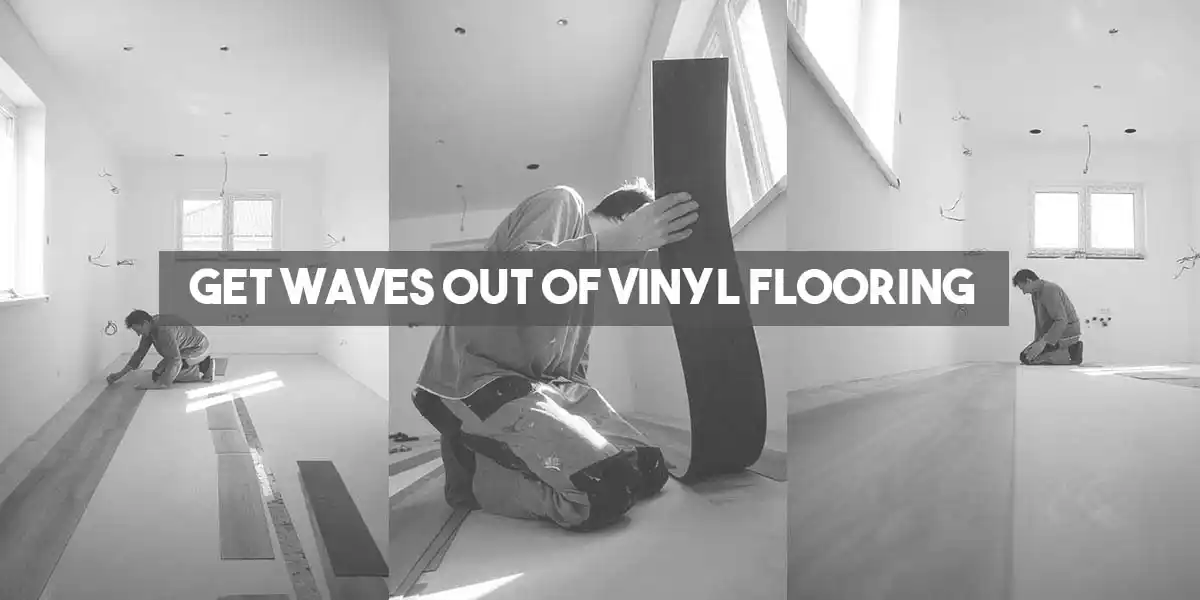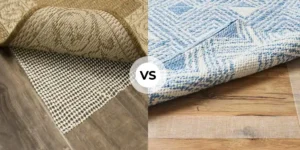Vinyl flooring is a fantastic choice – easy to clean, durable, and stylish. But what happens when those unexpected waves start showing up? Disrupting the smooth surface you love?
Whether it’s from an installation hiccup or changes in temperature and humidity. We’ve got your back.
According to Remodel or Move, there is a possibility that vinyl flooring will develop waves or ripples as it ages.
The problem of waves in your vinyl flooring does not need to be addressed by replacing it. There are several methods you can use to fix it.
In this article, we are going to provide some useful tips on how to get waves out of vinyl flooring. So that it can be restored to its original smooth and level surface.
Whether you’re a DIY veteran or a novice, these tips will help you achieve great results. So, let’s get started!
You Might Also Like:
What Causes Vinyl Flooring Waves?
Improper Installation
Generally, vinyl flooring waves are caused by incorrect installation of the flooring. Which is one of the most common causes of vinyl flooring waves.
Depending on how the flooring is installed. Or how the adhesive is applied. There is the possibility of waves forming over time if the floor is not installed properly.
If the adhesive is not allowed to dry completely before laying the flooring, buckles or warps may occur.
Also, vinyl flooring waves are often caused by the absence of a perimeter in the installation of the flooring.
As part of the installation process of vinyl flooring, a gap needs to be left between the floor edges and the walls. In this way, the flooring is capable of expanding and contracting without causing any waves or bumps to occur as a result.
Temperature and Humidity
Changes in temperature and humidity in a room can also cause vinyl flooring waves.
Vinyl flooring can absorb excess moisture when humidity levels are high. Which causes it to expand and form waves. Mostly, bathrooms and kitchens are among the areas where moisture levels are high. Which can lead to this type of problem.
Also, exposure to direct sunlight can cause vinyl flooring to expand and contract. This movement can result in waves or bumps on the flooring. This phenomenon is often observed in rooms with large windows or doors.
The Moisture
Vinyl flooring waves can also be caused by excessive moisture.
It can happen when water or other liquids seep through the seams due to spills on the flooring. So, the adhesive will loosen, and the flooring will buckle or warp. Basements and laundry rooms, which have high moisture levels, are particularly prone to this problem.
Moving Heavy Objects Over Loosely Laid Vinyl Flooring
Lastly, heavy objects can cause waves to form when moved across the flooring. If heavy objects are dragged over the floor, the floor may shift and buckle. Leading to waves or bumps along the surface.
4 Best Ways to Get Waves Out of Vinyl Flooring
1. Using a Heat Gun
Using a heat gun is an effective method of removing vinyl flooring waves. It softens vinyl flooring, which consequently loosens the adhesive. This allows you to reposition the flooring to remove any waves that have formed.
Here are the steps you can follow:
- Heat the affected area with a heat gun. Wear protective gloves and eyewear to prevent injuries.
- Use a putty knife or other flat tool to gently lift and smooth the vinyl flooring as it heats.
- It is important to wait before smoothing it out until the vinyl has cooled and set in place.
Be sure to follow all safety precautions when using a heat gun and use it carefully to avoid damaging the floor.
2. Put Heavy Furniture in Place
Removing vinyl flooring waves by placing heavy furniture. Objects in the affected area are also possible. Using this technique, you can weigh down the flooring and encourage it to settle in place.
Here’s how you do it:
- Locate the vinyl flooring waves.
- Put heavy furniture or objects on top of the affected area. Check that the weight is evenly distributed. And that furniture or objects won’t damage the flooring.
- After settling the vinyl flooring, leave the furniture or objects in place for several days or longer.
3. Applying adhesives
If you’re experiencing waves or bumps in your vinyl flooring, you can use adhesive to fix the issue. Using adhesive not only gets rid of any imperfections but also secures the vinyl floor to the subfloor.
Follow the below-written steps to remove any waves or bumps from your vinyl flooring:
- Firstly, using a lifter lifts the section of vinyl flooring that needs to be repaired.
- Next, thoroughly clean the subfloor by removing any debris or dirt using a vacuum.
- After that, apply adhesive to the underside of the vinyl flooring in the affected area.
- Then, press the vinyl flooring down onto the subfloor. While ensuring that there are no remaining bumps or waves.
- Finally, let the adhesive dry and set it for at least 30 minutes.
It is crucial to use the appropriate adhesive for your type of vinyl flooring. Be sure to follow the manufacturer’s instructions. With these steps, your vinyl flooring will be smooth and secure in no time.
4. Cutting and replacing
If the wave or damage to the floor is severe, cutting and replacing the affected area of the floor may be necessary. Ideally, you will be able to do this by removing the wave and replacing it with a straight piece.
Considering it requires skilled labor and time, this method is more challenging than the others we’ve discussed so far. So, if the floor is severely damaged, consulting a professional is recommended.
5. A Professional Can Help
It is advisable to hire a professional to remove waves from vinyl flooring.
Only if you are not sure how to deal with this wave on your own or unsure of what to do, you may want to hire a professional. Only a qualified professional can assess the situation. And determine the appropriate course of action.
Prevention Tips on How to Prevent Vinyl Flooring Waves
To prevent vinyl flooring waves in the future, follow these tips:
- Proper Installation: Vinyl flooring installation is one of the most important factors in preventing vinyl flooring waves. Having your vinyl flooring installed correctly by a professional will ensure it doesn’t have any bumps or waves.
- Allow Perimeter Expansion: Vinyl flooring can expand and contract due to changes in temperature and humidity. Keeping a perimeter expansion allowance is crucial to preventing waves. Leave a gap between the flooring and the wall to ensure movement.
- Use an adhesive: When installing vinyl flooring, it’s important to use the right adhesive and follow the manufacturer’s instructions. Over time, improper adhesive applications can cause waves.
- Avoid Hauling Heavy Objects: Vinyl flooring that is loosely laid should not be hauled over by heavy objects. Because of the pressure applied to the flooring, waves can form.
- Climate Control: A change in humidity or temperature may affect vinyl flooring. Maintaining consistent humidity and temperature in your home prevents your flooring from expanding and contracting. Which can cause waves.
FAQs: How to Get Waves Out of Vinyl Flooring?
1. Do waves and bumps appear over time?
Yes. Vinyl flooring can develop waves or bumps over time. Only when the adhesive holding it in place breaks down.
Additionally, temperature and humidity changes can cause vinyl flooring to expand and contract. Resulting in waves and bumps. The movement of heavy objects over the flooring can also create waves and bumps.
2. Can I use a steam mop to get rid of waves in vinyl flooring?
For vinyl flooring, it’s not recommended to use a steam mop. In the case of vinyl flooring waves, steam mops use high temperatures and moisture to clean and disinfect floors.
Exposure to high temperatures and moisture can cause vinyl flooring to expand, contract, and possibly warp. It can worsen the waves and even cause new ones to form.
3. Will waves in vinyl flooring go away on their own?
No. In most cases, waves in vinyl flooring will not simply disappear. It is generally necessary to intervene once waves have formed in the flooring to remove them.
Untreated waves may be more difficult to remove and cause greater damage to the flooring the longer they remain untreated.
Read More on Vinyl Floors
- Do I Need Expansion Gaps for Vinyl Flooring? (Explained)
- Does Vinyl Flooring Fade in the Sun? (6 Ways to Prevent From Fading)
- How to Fix Vinyl Flooring Seams? (A Step By Step Approach)
- 5 Reasons Why Your Vinyl Plank Floor Buckling (Guide To Fix It)
- How to Fix Gaps in Vinyl Plank Flooring? (5 Easy Steps)





